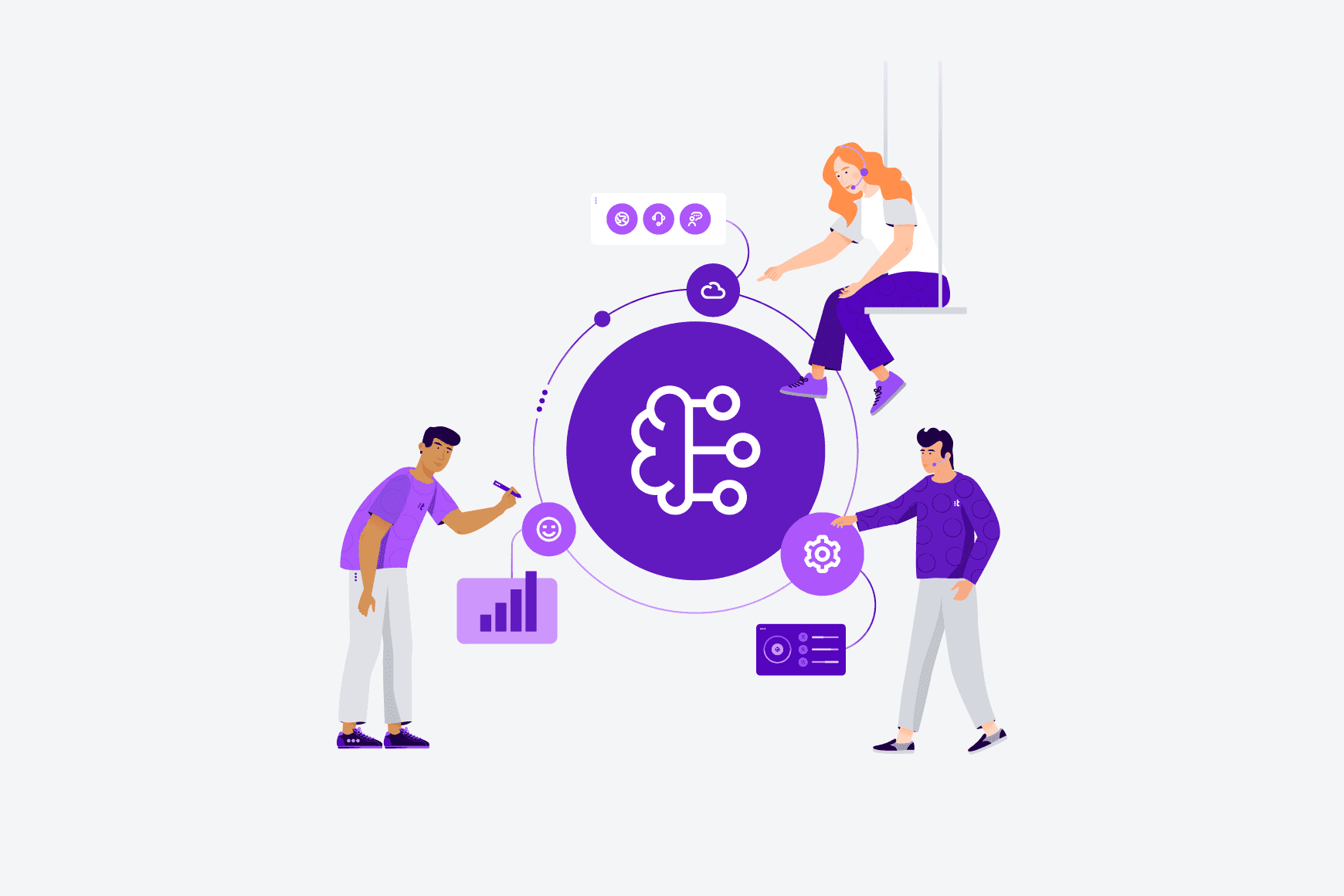Contact Center AI: How artificial intelligence is transforming the contact center

By Jafar Adibi
0 min read

Discover how AI is transforming the contact center operations and the opportunities that automation bring for customer service.
Customer experience and contact centers, in particular, are great starting points to implement artificial intelligence (AI) solutions since they are a large source of customer information, generating enormous quantities of data that is impossible to process manually.
Additionally, giant leaps in speech processing technology and natural language processing (NLP) are opening big opportunities to enhance contact center accuracy while promoting cost efficiency.
AI and NLP: What it is and how it works.
NLP, a heralded branch of AI, deals with the interaction between computers and humans using natural language. NLP makes sense of the human language in a manner that is valuable and contextual. If a customer says “I am free on Friday at 9:30 a.m.”, NLP understands that he is available to talk to an agent during that time slot and not “free of charge”.
Artificial intelligence has been a scientific research area for decades and the latest advances in computing capacity, data collection and transmission and NLP have generated much speculation on how this technology will evolve and what can be achieved in the next few years. However, this trend is not new. AI has lived through hyped periods, sometimes living up to expectations and sometimes not.
Cloud contact center AI: 8 ways it will revolutionize contact centers and other industries.
With the “AI winter” long gone, promises of a bright future lay ahead for AI technology and its applications across almost every industry and sector, including retail and e-commerce, financial services, healthcare, travel and hospitality, and more.
Cloud contact center AI is no stranger to this brave new world, full of opportunities that come in many forms:
- Automation. Follows pre-programmed rules to handle simple and often repetitive tasks in an expedited manner. You can automate the most repetitive tasks and let agents focus on delighting customers.
- Discovery. Some of the hidden rules in business, like data patterns in large contact center bases, went under the radar before due to sampling analysis. Relying on AI to cultivate data from billions of interactions leads to actionable discoveries and customer insights that drive predictive recommendations and optimize agent and contact center efficiency.
- Prediction models improvement. Many contact centers have prediction models in place already, but the new frontiers in AI can make them even better and more accurate.
- Prescription. AI should recognize new patterns and suggest the next best steps based on that recognition. Today, you can empower agents with intelligent guidance, recommending next best actions to quickly resolve complex customer issues.
- Alert. A contact center is constantly accumulating, processing and producing mountains of data. When something is going wrong, the AI brain should send an alert about specific data points. For instance, you can reduce short and long term training efforts through real-time error identification.
- Recommendation. The AI engine should recommend the next steps, or the next best action, proactively delivering information in one simple interface, thus preventing agents from being scattered between several data sources.
- Optimization. Recommendations from AI lead to optimization of the main metrics that define the performance of your contact center’s day-to-day operation. For example, you can improve Customer Satisfaction (CSAT) and Net Promoter Score (NPS) to reduce agent stress by eliminating search and browsing tasks to simplify agent effort.
- Assistance. Directly or indirectly, every persona in the contact center should be able to benefit from AI practical assistance for the tasks they are expected to perform. Contact centers should reduce manual supervision, leveraging automated assistance to trim down agent-supervisor ad-hoc interactions, giving supervisors more time to focus on workforce engagement activities and agents more quality time with customers.
Contact center AI software and how can it help customer service.
AI deployment has grown from 4% to 14% between 2018 and 2019. Despite this increase in adoption, the complexity of the technology, the implementation uncertainties and disruption potential are still blocking some organizations from full AI implementation. AI must be implemented across people, operations, and technology in four different intelligence layers of a contact center in order to leverage its full potential.
Where to implement AI software in the contact center:
1. People and operations. You can enhance the end customer experience by infusing AI software to help all the key personas within the contact center — provide AI-powered customer information and assistance to agents and feed supervisors with the main KPIs on agent performance. Automation, optimization, outlier detection, routing, marketing automation and virtual agents are all stages of the business operation where AI can also help.
2. Technology. You need a powerful contact center AI technology platform if you want to capture quality data. Without one, you can not do anything about AI. There is no point in adding a virtual agent or chatbot if you simply do not have the right contact center AI technology in place to capture and process that data. AI works on top of a good data platform and for that you need an intelligent infrastructure architecture as well.
Intelligence layers of AI for contact centers:
1. Customer intelligence. It is important to know as much about your customer as you can, even before they call. When you have a lot of information stored in your customer relationship management (CRM) it allows you to know more about your customer. You must be able to analyze it to understand what they need and their preferences, their demographics, sociographics and even psychographics.
2. Conversational intelligence. It happens at the moment the customer calls and means the extraction of every information taken from the interaction. It can be voice, voice transferred to text, and text. You should be able to handle all these items, since there is a lot of information from voice that cannot be transcribed into text, such as agony, compassion, pain or being sarcastic. This takes place within the voice channel and not in the text channel.
3. Interaction intelligence. Comprehensive analysis of the customer experience from the moment the customer dials your number. Do you know what the estimated wait time for the call was? Sometimes simple numbers can shed light upon an entire conversation by knowing the complete customer experience. If the estimated wait time was only two minutes, but the actual waiting time was 10 minutes, the customer was likely unhappy when the conversation with the agent began. These data points should not be ignored since they can improve your CX.
4. Contact center intelligence. Analyze every customer interaction, conversation, email thread, and text. Hover above this data and from a panoramic view ask: What is going on in my contact center? How can I improve its entire performance?
AI promises are transforming the contact center, pushing the boundaries for excellence in customer experience. The Implementation of AI software in all its different layers can bring sound improvements to contact center personas, operations and technology systems. This AI wave of fast-changing circumstances is the perfect opportunity for CX leaders to be early adopters of cutting edge technology that takes the contact center to the fore-front of an AI-powered revolution.
Join me as I will be sharing three steps to infusing AI in the contact center in my next blog.

ebook
5 steps to AI success: leading contact centers to a Netflix-like customer experience






